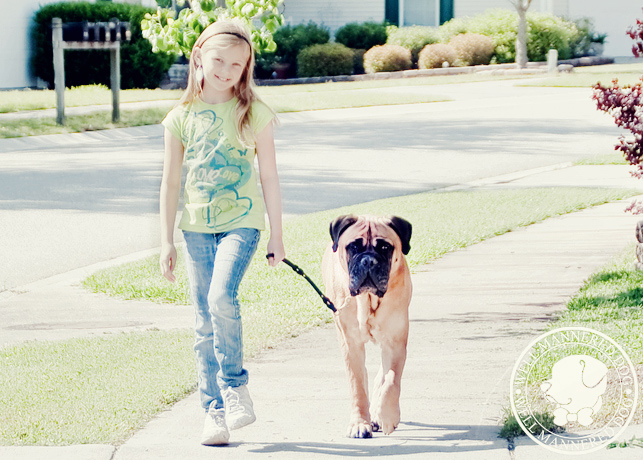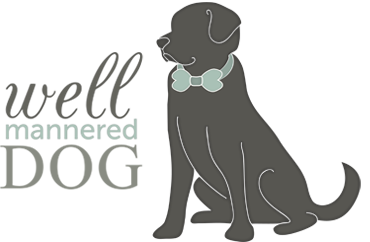
DOG TRAINING CHARLESTON, SC
obedience training
Any Age, Any Size, Any Breed
Obedience training is a set series of commands in which your dog is taught to respond to a verbal command or hand signal. All dogs are capable of learning every command no matter what their age, size or breed. A dog with a good set of obedience skills is a happier, more confident pet that you can rely on. There are multiple way to teach every command. Well Mannered Dog will customize an effective method for you and your dog.

Bullmastiff Executing the Heel Command
Why You Should Train Your Dog
Training plays a key role in building a good relationship with your dog. It’s not just about fun tricks or showing off, it is about communicating with your dog so both of you are happier. Remember, dogs do not instinctively know how you want them to behave, you have to teach them! Here are just a few of the reasons why you should obedience train your dog:
- Obedience training is the foundation for solving almost any behavior problem.
- Obedience training is a humane way to teach your dog who is in control.
- Obedience training betters your relationship and makes living together more enjoyable.
- Obedience training gives your dog more confidence and freedom.
- Obedience training can save your dog’s life.
Examples of Commands:
| Command: | Explanation: | Usage: |
| Control Walking – “Lets Walk” | During training your dog learns casual walking manners. Forging ahead, lingering behind and sniffing around are allowed as long as your dog remains off to your left side and does not pull on the leash. | Casual walk throughout your neighborhood. |
| Heel w/Auto-sit – “Fido Heel” | Once given the command to heel, your dog will have to maintain a position on your left side with his/her collar next to your left leg. If you should change your direction, your dog will change his/hers to stay at your side without guidance from the leash. During the training process, we teach your dog to heel past distractions. The heel command requires better concentration from your dog than a controlled walk, and keeps your dog safe at your side. | Walking in a crowd or around distractions and children. |
| Sit/Stay – “Fido Sit” | This command, when properly taught, teaches your dog to sit on the first command. Once your dog hears the stay command, he must remain sitting until you use the release command or password. Our trainers will teach your dog to stay with a few distractions. Your dogs first stay will only last 2 seconds, after the training your dog should stay for at least 3 minutes. Your dog should be able to maintain a stay even if he would rather jump on your company. | In front of food dish, at doorways, veterinarian office and sitting calmly for petting. |
| Down/Stay – “Fido Down” | This command teaches your dog to lay down. Just like the stay in sit/stay your dog will wait for permission before getting up. You should be able to step over your dog while he is in a down position. Being told to lay down can make a dog nervous, once your dog sees that downing pleases you, he will accept it better and have a higher degree of trust for you. | Helps to build trust, assists in gaining leadership, and calms and relaxes your dog. |
| Come Command – “Fido Come” | This is the most important command your dog will learn. We teach this command using several different techniques to ensure your dog learns it very well. When given the command to come, your dog should be able to break away from distractions and come directly to you and hold a sit in front of you until given the release command. We like to think of your dog’s commands as a game that your dog must play. His life may depend on how well he does this command. | Call your dog away from danger, useful during games and retrieving exercises. |
| Place Command – “Fido Place” | The most favorite and used command we teach. This command teaches your dog to go to his bed, from anywhere in the home, on command. Once there, he can lay down, play with toys, or just nap. This is not punishment. Place is a happy command. Your dog can learn to place for up to 1-1/2 Hours at a time. | During dinner, when company comes over, signing for a package, and as a calming command. |
| Stand/Stay – “Fido Stand” | This command teaches your dog to stand on all fours and stay for grooming, bathing and for the conformation show ring. It is also useful if you need to wipe off muddy paws. | Helps with bathing, brushing, and vet examinations. It is also used in the show ring. |
| Emergency Stop – “Fido Down” | This command is possibly one of the hardest to teach. Your dog learns that even on a full run to stop and drop into the down position when the command is given. This command is taught in several stages and takes longer then most other commands. | To stop your dog from coming to you, if something dangerous is in his/her path. |
| Emergency Come Command – “Rhythmic whistle blast” | Your voice can only carry for about one city block. We teach your dog to respond to a rhythmic whistle blast as an emergency come command. This will allow you call your dog when you are unable to reach him with the sound of your voice. | Great for hiking, beach conditions, and for lost dogs! |
| Doorway Entry – “Wait” | This is an assumed command. We teach your dog to wait for permission to pass through an open doorway leading into and out of your home. Once your dog’s understanding is clear, you will not have to give a command to cause your dog not to pass through the door. He/She will always assume that they are not to pass unless you give the release command. | Entry into and out of cars, great for front door greeting and bringing in groceries. |
| Hand Signals – “Visual Cue” | During training, our instructors will use a hand signal with each command. Your dog will learn the commands faster when a unique hand signal is taught for each command. | Speeds learning of commands, extends your dogs range to follow commands and teaches your dog to watch you more closely in anticipation of commands. |
| Off Leash Techniques | Teaching your dog to respond to all the commands is relatively easy. However, teaching him/her to respond to the commands OFF the leash is a unique challenge. Our trainers are taught many methods for breaking your dog’s dependency on the leash. During the training, there are three phases of off leash training. You can choose the level needed for your situation. | Safety concerns, handy when playing ball, and allowing your dog to run free at the beach or on hikes. |
| Return to Heel – “Heel” | When your dog hears the command to heel, he/she must come directly to you and turn and sit at your left side. | Great for getting ready for a walk, putting the leash on your dog, and used in our Protection Training packages. |
| Extended Stays – “Stay” | During basic training, most dogs learn to stay for a short time frame. Our extended stays are built upon those shorter stays. Your dog can learn to hold some stays as long as 20 minutes or more. | During walks, if you stop to speak with a neighbor for ten minutes, your dog can maintain a stay the entire time. |
© 2013 Well Mannered Dog Training Charleston, SC

